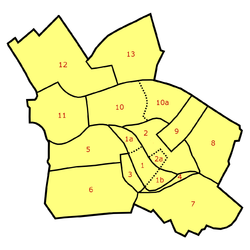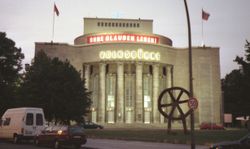
Scheunenviertel
Encyclopedia

Mitte
Mitte is the first and most central borough of Berlin. It was created in Berlin's 2001 administrative reform by the merger of the former districts of Mitte proper, Tiergarten and Wedding; the resulting borough retained the name Mitte. It is one of the two boroughs which comprises former West and...
in the centre of Berlin
Berlin
Berlin is the capital city of Germany and is one of the 16 states of Germany. With a population of 3.45 million people, Berlin is Germany's largest city. It is the second most populous city proper and the seventh most populous urban area in the European Union...
. It is situated to the north of the medieval Altberlin area, east of the Rosenthaler Straße and Hackescher Markt
Hackescher Markt
The Hackescher Markt is a square in the central Mitte locality of Berlin, Germany, situated at the eastern end of Oranienburger Strasse....
. Until the Second World War
World War II
World War II, or the Second World War , was a global conflict lasting from 1939 to 1945, involving most of the world's nations—including all of the great powers—eventually forming two opposing military alliances: the Allies and the Axis...
it was regarded as a slum
Slum
A slum, as defined by United Nations agency UN-HABITAT, is a run-down area of a city characterized by substandard housing and squalor and lacking in tenure security. According to the United Nations, the percentage of urban dwellers living in slums decreased from 47 percent to 37 percent in the...
district and had a substantial Jewish population with a high proportion of migrants from Eastern Europe.
History
The name derives from several barnBarn
A barn is an agricultural building used for storage and as a covered workplace. It may sometimes be used to house livestock or to store farming vehicles and equipment...
s erected here outside the city walls
Defensive wall
A defensive wall is a fortification used to protect a city or settlement from potential aggressors. In ancient to modern times, they were used to enclose settlements...
in 1672 by order of Elector Frederick William of Brandenburg
Frederick William, Elector of Brandenburg
|align=right|Frederick William was Elector of Brandenburg and Duke of Prussia – and thus ruler of Brandenburg-Prussia – from 1640 until his death. A member of the House of Hohenzollern, he is popularly known as the "Great Elector" because of his military and political prowess...
. The barns were used to store hay
Hay
Hay is grass, legumes or other herbaceous plants that have been cut, dried, and stored for use as animal fodder, particularly for grazing livestock such as cattle, horses, goats, and sheep. Hay is also fed to pets such as rabbits and guinea pigs...
in connection to a large cattle
Cattle
Cattle are the most common type of large domesticated ungulates. They are a prominent modern member of the subfamily Bovinae, are the most widespread species of the genus Bos, and are most commonly classified collectively as Bos primigenius...
market at nearby Alexanderplatz
Alexanderplatz
Alexanderplatz is a large public square and transport hub in the central Mitte district of Berlin, near the Fernsehturm. Berliners often call it simply Alex, referring to a larger neighborhood stretching from Mollstraße in the northeast to Spandauer Straße and the City Hall in the southwest.-Early...
. In 1737 King
King in Prussia
King in Prussia was a title used by the Electors of Brandenburg from 1701 to 1772. Subsequently they used the title King of Prussia....
Frederick William I of Prussia
Frederick William I of Prussia
Frederick William I of the House of Hohenzollern, was the King in Prussia and Elector of Brandenburg from 1713 until his death...
required Berlin Jews to settle here.
Prior to World War I
World War I
World War I , which was predominantly called the World War or the Great War from its occurrence until 1939, and the First World War or World War I thereafter, was a major war centred in Europe that began on 28 July 1914 and lasted until 11 November 1918...
the Berlin City Council
City council
A city council or town council is the legislative body that governs a city, town, municipality or local government area.-Australia & NZ:Because of the differences in legislation between the States, the exact definition of a City Council varies...
(Magistrat) redeveloped parts of the area. Since then the core of the neighborhood is the triangular Rosa-Luxemburg-Platz
Rosa-Luxemburg-Platz
The Rosa-Luxemburg-Platz is a square in Berlin-Mitte, Germany.The square is dominated by the Volksbühne and by the Karl-Liebknecht-Haus, the headquarters of the German Left Party...
, former Bülowplatz, where on August 9, 1931 the Communist and later Stasi
Stasi
The Ministry for State Security The Ministry for State Security The Ministry for State Security (German: Ministerium für Staatssicherheit (MfS), commonly known as the Stasi (abbreviation , literally State Security), was the official state security service of East Germany. The MfS was headquartered...
Executive Erich Mielke
Erich Mielke
Erich Fritz Emil Mielke was a German communist politician and Minister of State Security—and as such head of the Stasi —of the German Democratic Republic between 1957 and 1989. Mielke spent more than a decade as an operative of the NKVD during the rule of Joseph Stalin...
shot two police officer
Police officer
A police officer is a warranted employee of a police force...
s. Mielke fled to Moscow
Moscow
Moscow is the capital, the most populous city, and the most populous federal subject of Russia. The city is a major political, economic, cultural, scientific, religious, financial, educational, and transportation centre of Russia and the continent...
shortly afterwards and did not face trial for the murders until 1992.
Following German reunification
German reunification
German reunification was the process in 1990 in which the German Democratic Republic joined the Federal Republic of Germany , and when Berlin reunited into a single city, as provided by its then Grundgesetz constitution Article 23. The start of this process is commonly referred by Germans as die...
the Scheunenviertel, together with the neighbouring Spandauer Vorstadt, has become a fashionable district popular with younger people.
Note that Scheunenviertel is often mistakenly used as a synonym for Berlin's Jewish quarter. Jewish cultural and commercial life was however centred on the neighbouring Spandauer Vorstadt, where the New Synagogue and other Jewish establishments are located.
Sights

- VolksbühneVolksbühneThe Volksbühne is a theater in Berlin, Germany. Located in Berlin's city center Mitte on Rosa-Luxemburg-Platz in what was the GDR's capital....
theatre at Rosa-Luxemburg-Platz by Oskar KaufmannOskar KaufmannOskar Kaufmann was an Hungarian-Jewish architect...
and Franz MetznerFranz MetznerFranz Metzner was an influential German sculptor, particularly his sculptural figures integrated into the architecture of Central European public buildings in the Art Nouveau / Jugendstil / Vienna Secession period...
, 1914 - Karl-Liebknecht-HausKarl-Liebknecht-HausThe Karl-Liebknecht-Haus or Karl Liebknecht House is the headquarters of the Party The Left in Germany. It is located between the Alexanderplatz and Rosa-Luxemburg-Platz in Berlin-Mitte....
, 1912, former seat of the Central Committee of the Communist Party of GermanyCommunist Party of GermanyThe Communist Party of Germany was a major political party in Germany between 1918 and 1933, and a minor party in West Germany in the postwar period until it was banned in 1956...
(Kommunistische Partei Deutschlands), now headquarters of The LeftThe Left (Germany)The Left , also commonly referred to as the Left Party , is a democratic socialist political party in Germany. The Left is the most left-wing party of the five represented in the Bundestag....
party (Die Linke) - "Babylon" Cinema by Hans PoelzigHans PoelzigHans Poelzig was a German architect, painter and set designer.-Life:Poelzig was born in Berlin in 1869 to the countess Clara Henrietta Maria Poelzig while she was married to George Acland Ames, an Englishman...
, 1929, a location of the annual Berlin International Film FestivalBerlin International Film FestivalThe Berlin International Film Festival , also called the Berlinale, is one of the world's leading film festivals and most reputable media events. It is held in Berlin, Germany. Founded in West Berlin in 1951, the festival has been celebrated annually in February since 1978... - Old Garrison Cemetery (Alter Garnisonsfriedhof), dedicated about 1706, burial site of lieutenant generalLieutenant GeneralLieutenant General is a military rank used in many countries. The rank traces its origins to the Middle Ages where the title of Lieutenant General was held by the second in command on the battlefield, who was normally subordinate to a Captain General....
Ludwig Adolf Wilhelm von LützowLudwig Adolf Wilhelm von LützowLudwig Adolf Wilhelm Freiherr von Lützow was a Prussian lieutenant general notable for his organization and command of a Lützow Freikorps of volunteers during the Napoleonic Wars...
(1782–1834), writerWriterA writer is a person who produces literature, such as novels, short stories, plays, screenplays, poetry, or other literary art. Skilled writers are able to use language to portray ideas and images....
Friedrich de la Motte FouquéFriedrich de la Motte FouquéFriedrich Heinrich Karl de la Motte, Baron Fouqué was a German writer of the romantic style.-Biography:He was born at Brandenburg an der Havel, of a family of French Huguenot origin, as evidenced in his family name...
(1777–1843), field marshalField MarshalField Marshal is a military rank. Traditionally, it is the highest military rank in an army.-Etymology:The origin of the rank of field marshal dates to the early Middle Ages, originally meaning the keeper of the king's horses , from the time of the early Frankish kings.-Usage and hierarchical...
Karl Friedrich von dem KnesebeckKarl Friedrich von dem KnesebeckKarl Friedrich von dem Knesebeck was a Prussian field marshal and military adviser in the Napoleonic Wars.- Early life :...
(1768–1848) and theologianTheologyTheology is the systematic and rational study of religion and its influences and of the nature of religious truths, or the learned profession acquired by completing specialized training in religious studies, usually at a university or school of divinity or seminary.-Definition:Augustine of Hippo...
Emil FrommelEmil FrommelEmil Frommel was a German theologian and author, born at Karlsruhe. He studied at Halle upon Saale, Erlangen, and Heidelberg, held several pastorates, served as army chaplain in the Franco-German War of 1870–1871 and in 1872 was appointed court preacher at Berlin and pastor of the garrison in that...
(1828–96).
See also
- History of BerlinHistory of BerlinBerlin is the capital city of Germany. Berlin is a young city by European standards, founded in the 12th century.-Early history:*98 AD: Tacitus described the territory of Germania. What is now Berlin, in ancient times was well outside the frontiers of the Roman Empire...

